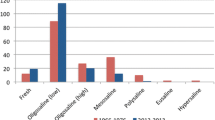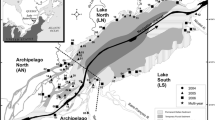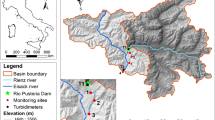Abstract
Using a reference-condition comparison, recovery of benthic invertebrate communities from acidification was assessed in three lakes in Killarney Wilderness Park approximately 40–60 km from the massive metal smelters in Sudbury, Canada. Test site analyses (TSAs) were used to compare the park lakes to 20 reference lakes near Dorset Ontario, 200 km to the east. An extension of a previous survey (1997–2001) of two sensitive mayfly species (Stenonema femoratum and Stenacron interpunctatum) was conducted in one of the lakes. TSA results indicate that the three Killarney lakes remain significantly different from reference condition due primarily to higher abundances of a few acid-tolerant families and the presence of some less abundant sensitive families. Colonization rates differ greatly between the two mayfly species presumably because of competition for available habitat. Overall, this study suggests that early colonizers will gain an advantage to out-compete subsequent arrivals, and these competitive interactions will delay the return of communities to reference condition.
Similar content being viewed by others
References
Beamish, R. J., & Harvey, H. H. (1972). Acidification of the La Cloche Mountain Lakes, Ontario and resulting fish mortalities. Journal of the Fisheries Research Board of Canada, 29, 1131–1143.
Bowman, M. F., & Somers, K. M. (2006). Evaluating a novel Test Site Analysis (TSA) bioassessment approach. Journal of the North American Benthological Society, 25(3), 712–717. doi:10.1899/0887-3593(2006)25[712:EANTSA]2.0.CO;2.
Carbone, J., Keller, W., & Griffiths, R. W. (1998). Effects of changes in acidity on aquatic insects in rocky littoral habitats of lakes near Sudbury, Ontario. Restoration Ecology, 6(4), 376–389. doi:10.1046/j.1526-100X.1998.06408.x.
Curry, R. A., & Powles, P. M. (1991). The insect community in an outlet stream of an acidified lake. Naturaliste Canadien, 118, 27–34.
DeMeester, L., Gomez, A., Okamura, B., & Schwerik, K. (2002). The monopolization hypothesis and the dispersal-gene flow paradox in aquatic organisms. Acta Oecologica, 23, 121–135. doi:10.1016/S1146-609X(02)01145-1.
Giberson, D. J., & MacKay, R. J. (1991). Life history and distribution of mayflies (Ephemeroptera) in some acid streams in south central Ontario, Canada. Canadian Journal of Zoology, 69(4), 899–910. doi:10.1139/z91-135.
Hauer, F. R., & Lamberti, G. A. (2007). Methods in stream ecology, 2nd edition. New York: Academic.
Keller, W., Heneberry, J. H., & Dixit, S. S. (2003). Decreased acid deposition and the chemical recovery of Killarney, Ontario, lakes. Ambio, 32(3), 183–189.
Keller, W., Heneberry, J. H., McLachlan, E., & MacPhee, S. (2006). Data report: 25 years of extensive monitoring of acidified lakes in the Sudbury area, 1981–2005. Sudbury, ON: Cooperative Freshwater Ecology Unit.
Keller, W., Yan, N. D., Gunn, J. M., & Heneberry, J. (2007). Recovery of acidified lakes: Lessons from Sudbury, Ontario, Canada. Water Air and Soil Pollution Focus, 7(1–3), 317–322. doi:10.1007/s11267-006-9061-2.
Kerekes, J., Freedman, B., Howell, G., & Clifford, P. (1984). Comparison of the characteristics of an acidic eutrophic, and an acidic oligotrophic lake near Halifax, Nova Scotia. Water Pollution Research Journal of Canada, 19, 1–10.
Krekes, J., & Freeman, B. (1989). Characteristics of three acidic lakes in Kejimkujik National Park, Nova Scotia, Canada. Archives of Environmental Contamination and Toxicology, 18(1–2), 183–200. doi:10.1007/BF01056203.
Ledger, M., & Hildrew, A. (2005). The ecology of acidification and recovery: Changes in herbivore–algal food web linkages across a stream ph gradient. Environmental Pollution, 137(1), 103–118. doi:10.1016/j.envpol.2004.12.024.
McCafferty, W. P. (1998). Aquatic Entomology: The fisherman’s and ecologists’ illustrated guide to insects and their relatives. Boston: Science Books International.
Merritt, R. W., & Cummins, K. W. (1996). An Introduction to the aquatic insects of North America, 3rd Edition. Iowa: Kendal/Hunt.
Monteith, D., Hildrew, A., Flower, R., Raven, P., Beaumont, W., Collen, P., et al. (2005). Biological responses to the chemical recovery of acidified fresh waters in the UK. Environmental Pollution, 137(1), 83–101. doi:10.1016/j.envpol.2004.12.026.
Oliver, B. G., & Kelso, J. R. M. (1983). A role for sediments in retarding the acidification of headwater lakes. Water, Air, and Soil Pollution, 20, 379–389. doi:10.1007/BF00208512.
Peckarsky, B. L., Fraissinet, P., Penton, M. A., & Conklin, D. J., Jr. (1990). Freshwater macroinvertebrates of Northeastern North America. New York: Cornell University Press.
Potvin, R. R., & Negusanti, J. J. (1995). Declining industrial emissions, improving air quality, and reduced damage to vegetation. In J. M. Gunn (Ed.), Restoration and recovery of an industrial region. New York: Springer.
Prejs, K., & Lazarek, S. (1988). Benthic nematodes in acidified lakes: Case of a neglected grazer. Hydrobiologia, 169, 193–197.
Rowe, L., & Berrill, M. (1989). The life cycles of five closely related mayfly species (Ephemeroptera: Heptageniidae) coexisting in a small Southern Ontario stream pool. Aquatic Insects, 11(2), 73–80. doi:10.1080/01650428909361351.
Snucins, E. (2003). Recolonization of acid-damaged lakes by the benthic invertebrates Stenacron interpunctatum, Stenonema femoratum, and Hyalella azteca. Ambio, 32(3), 225–229.
Snucins, E., & Gunn, J. M. (1998). Chemical and biological status of Killarney Park lakes (1995–1997), a study of lakes in the early stages of recovery from acidification. Sudbury, ON: Ontario Ministry of Natural Resources, Cooperative Freshwater Ecology Unit.
Snucins, E., Gunn, J. M., Keller, W., Dixit, S. S., Hindar, A., & Henriksen, A. (2001). Effects of regional reductions in sulphur deposition on the chemical and biological recovery of lakes within Killarney Park, Ontario, Canada. Environmental Monitoring and Assessment, 67, 179–194. doi:10.1023/A:1006434622970.
Wiggins, G. B. (1996). Larvae of North American caddisfly genera (Trichoptera), 2nd edition. Toronto: University of Toronto Press.
Author information
Authors and Affiliations
Corresponding author
Rights and permissions
About this article
Cite this article
Szkokan-Emilson, E.J., Wesolek, B.E., Gunn, J.M. et al. Recovery of benthic invertebrate communities from acidification in Killarney Park lakes. Environ Monit Assess 166, 293–302 (2010). https://doi.org/10.1007/s10661-009-1002-x
Received:
Accepted:
Published:
Issue Date:
DOI: https://doi.org/10.1007/s10661-009-1002-x




